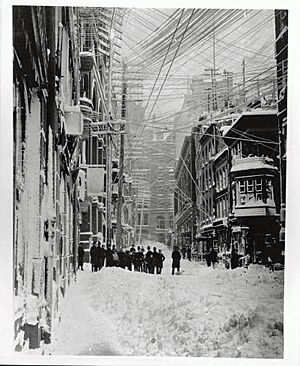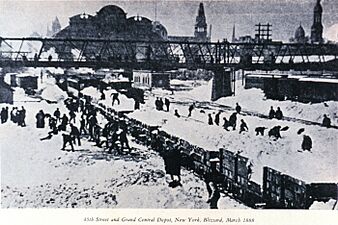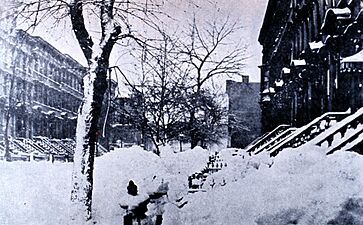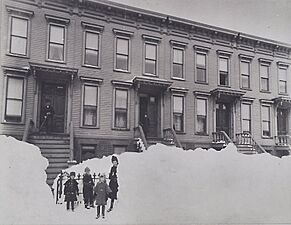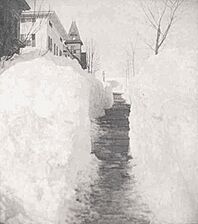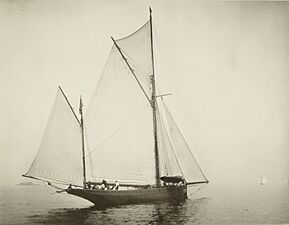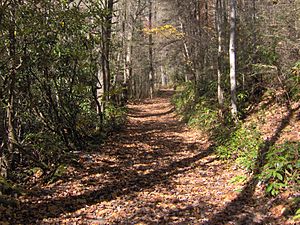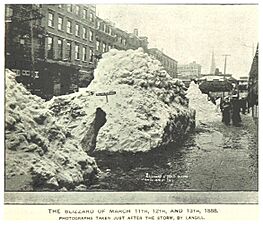Great Blizzard of 1888 facts for kids
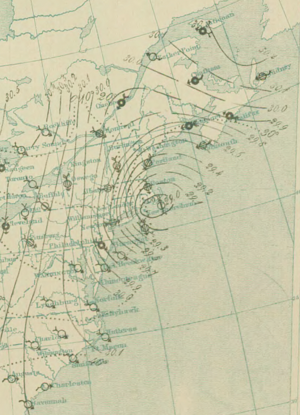
Weather map of the Blizzard on March 12, 1888.
|
|
| Type | A powerful winter storm and Blizzard |
|---|---|
| Lowest pressure | 980 hPa (29 inHg) |
| Maximum snowfall or ice accretion | 58 inches (1.5 m) |
| Damage | $25 million in 1888 (which would be about $810 million today) |
| Total fatalities | About 400 people died |
| Areas affected | Eastern United States, Eastern Canada |
The Great Blizzard of 1888, also known as the Great White Hurricane, was one of the worst snowstorms ever recorded in American history. It happened from March 11 to 14, 1888. This huge blizzard brought the East Coast to a complete stop. It affected areas from Chesapeake Bay all the way up to Maine, and even parts of Canada.
Imagine snow falling from 10 to 58 inches (25 to 147 cm) deep! This happened in places like New Jersey, New York, Massachusetts, Rhode Island, and Connecticut. Strong winds, blowing over 45 miles per hour (72 km/h), piled the snow into giant snowdrifts. Some of these drifts were taller than 50 feet (15 meters)! Trains stopped running, and many people had to stay in their homes for a whole week. The storm also broke telegraph lines. This led to an important change: cities started moving these wires underground to protect them from future storms.
Contents
How the Great Blizzard Formed
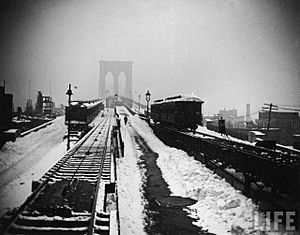
Just before the blizzard, the weather was unusually warm. Heavy rains fell, but then temperatures dropped very quickly. The rain soon turned into snow.
On March 12, the temperature in New York City plunged from 33°F (0.5°C) to 8°F (-13°C). The snow started around 1 A.M. and kept falling heavily for a day and a half.
Weather experts from the National Weather Service later estimated how much snow fell. Parts of Connecticut and Massachusetts got as much as 50 inches (127 cm) of snow. New Jersey and New York saw up to 40 inches (102 cm). Northern Vermont had between 20 and 30 inches (51 to 76 cm) of snow.
Incredible Snow Drifts and Fierce Winds
The snow wasn't just deep; it was piled high by strong winds. Snow drifts often reached 30 to 40 feet (9 to 12 meters) tall. These drifts were so high they covered the tops of houses in many areas from New York to New England. Some reports even said drifts covered three-story buildings!
The tallest snow drift was an amazing 52 feet (16 meters) in Gravesend, Brooklyn. Other places had huge amounts of snow too. Saratoga Springs, New York received 58 inches (147 cm). Albany, New York had 48 inches (122 cm). New Haven, Connecticut got 45 inches (114 cm), and New York City saw 22 inches (56 cm).
The storm also brought very strong winds. Some wind gusts were reported at 80 miles per hour (129 km/h). In New York City, the official highest wind speed was 40 mph (64 km/h). A gust of 54 mph (87 km/h) was recorded at Block Island. On March 13, New York City had a low temperature of 6°F (-14°C). This was the coldest temperature ever recorded so late in the winter season.
How the Blizzard Changed Everything
The Great Blizzard of 1888 had a huge impact on daily life and even led to new inventions.
Travel and Communication Challenges
In New York, trains and roads were completely blocked for many days. It took eight days to clear the snow from the rail line near Westport, Connecticut.
This massive transportation problem helped inspire a big change. It led to the creation of the first underground subway system in the United States. This subway opened in Boston nine years later. New York City also opened its first underground subway line in 1904, which grew into the New York City Subway we know today.
The New York Stock Exchange even closed for two days because of the storm. A weather-related closure like that wouldn't happen again for many years, until Hurricane Sandy in 2012.
Telegraph lines, which were how people communicated long distances, also broke down. This cut off cities like Montreal and many major cities in the northeastern U.S. from Washington, D.C. to Boston for days. After the storm, New York City started moving its telegraph and telephone wires underground. This protected them from future storms.
Fires and Shipwrecks
Fire stations couldn't move their equipment through the deep snow. This meant fires caused a lot of damage. The total loss from fires alone was estimated at $25 million in 1888. That would be about $810 million today.
Out at sea, the storm was just as dangerous. More than 200 ships were either stuck or wrecked from the Chesapeake Bay up through New England. Sadly, at least 100 sailors lost their lives.
After the blizzard, the melting snow caused severe flooding, especially in Brooklyn. This area was prone to flooding because of its natural landscape.
Not Everywhere Was Hit Hard
Interestingly, not every place was affected equally. An article from the Cambridge Press newspaper, published five days after the storm, mentioned that their area didn't get much snow. It said the total depth was less than ten inches (25 cm) on flat ground. If it hadn't been for the strong wind, it would have seemed like a small snowfall there.
A Famous Story from the Blizzard
Roscoe Conkling was a very important politician from the Republican Party. He became ill and died after trying to walk home through the blizzard.
The National Geographic Society magazine featured an article about the Great Blizzard in its very first issue. This was on October 1, 1888. The article, written by Edward Everett Hayden, told the brave story of the crew of the pilot-boat Charles H. Marshall, No. 3.
Images for kids
-
45th Street and Grand Central Depot in Manhattan, on March 12.
-
Park Place in Brooklyn on March 14.
-
New Britain, Connecticut, on March 13.


